By Shimian
Service Mesh is no longer an emerging concept, and there have been many explorations and practices about Service Mesh.
Currently, Istio is the most popular open-source service mesh, which consists of a control plane and a data plane.
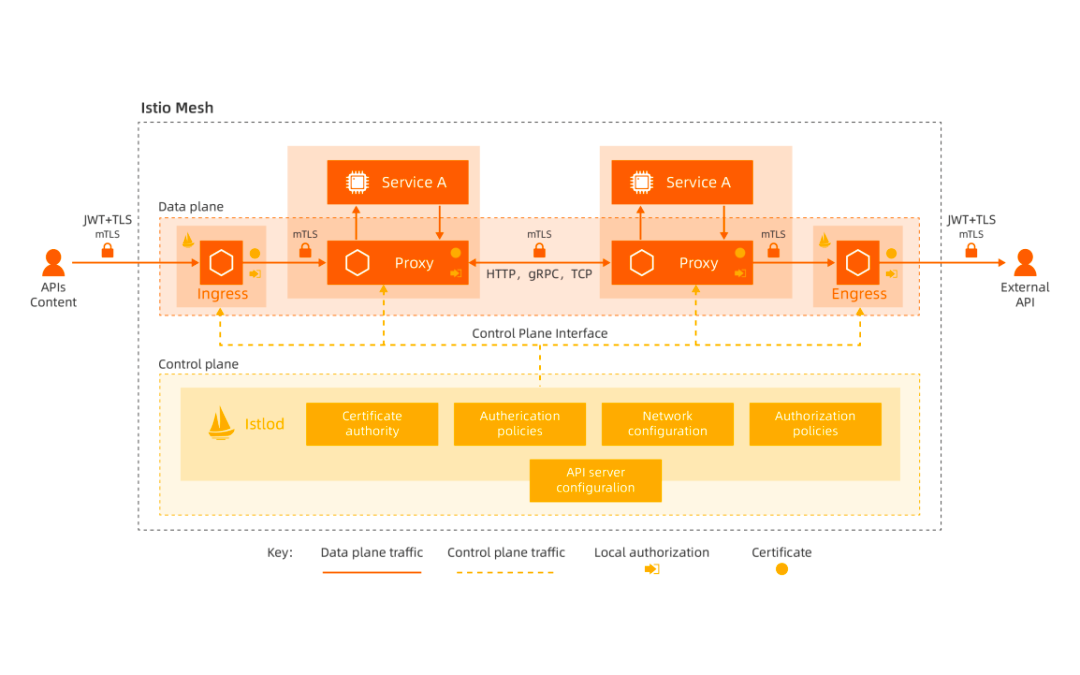
In the Istio Mesh architecture, the control plane is a process named Istiod, and the network proxy is Envoy. As a unified component of the control panel, Istio is used to integrate capabilities (such as service registration and discovery, routing rule management, and certificate management). Envoy acts as the data plane to proxy business traffic in Sidecar mode. Data (such as service discovery and routing rules) are transmitted between Istio and Envoy through xDS protocol interfaces. Istiod monitors Kubernetes resources (such as Services and Endpoints) to obtain service information and sends these resources to the network proxy on the data plane through the xDS protocol. Envoy is a process that is independent of an application. It runs along with the application Pods in Sidecar mode (commonly in the Container mode). It shares the same host network with the application process and hijacks the network traffic of the application by modifying the routing table.
Please see xDS REST and gRPC protocol Document[1] for more information about the xDS protocol interface.
With the increase in cluster size and business complexity, it is difficult for the container orchestration solution based on the native Kubernetes to cope with the business requirements, and developers have to face huge service governance challenges. Service Mesh can solve this problem. It encapsulates the service governance capabilities in the control plane and proxy, and business developers only need to focus on the business logic. After the application is deployed, O&M personnel only need to modify the configuration to implement many service governance capabilities (such as fault recovery, load balancing, and grayscale release). This significantly improves the R&D and iteration efficiency.
The Sidecar of Istio accompanies the entire lifecycle of business application processes through container injection. It is non-intrusive to business applications. This solves the problems of business application migration, multi-language, and infrastructure coupling. However, this brings problems (such as high resource consumption and increased request latency). Considering the disadvantages of Sidecar, we can consider using SDK to replace Sidecar to support the data plane, which leads to the architecture of Proxyless Mesh.
What is Proxyless Service-Mesh? This is a new concept proposed in recent years. Open-source communities (such as Istio, gRPC, and brpc) have explored and practiced in this direction. The Proxyless Service-Mesh framework is introduced by business applications in the form of SDK and is responsible for the communication and governance between services.
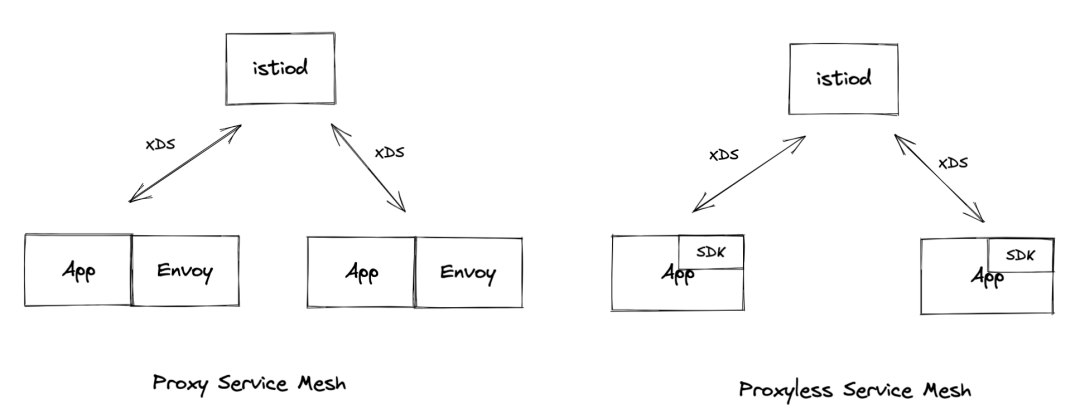
Currently, the gRPC project provides certain support for the xDS API protocol, which means we can manage gRPC services through Istio without deploying the Envoy sidecar.
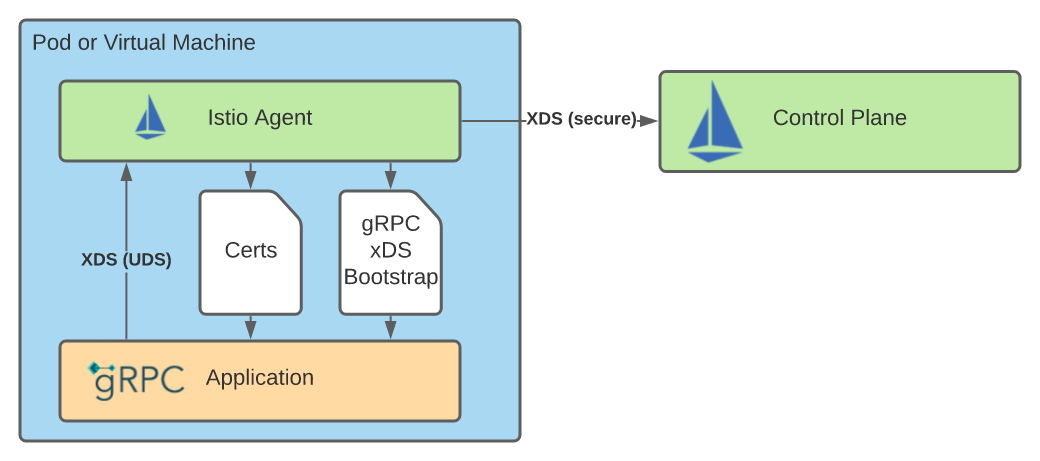
As shown in the preceding figure, the gRPC Proxyless mode requires the Istio Agent to initialize and communicate with the control panel. First, the Istio Agent generates a boot file at startup, which is the same way the boot file is generated for Envoy. It is used to tell the gRPC library how to connect to istiod, where to find the certificate for data panel communication, and what metadata to send to the control panel. Next, the Istio Agent acts as an xDS proxy to connect and authenticate with istiod on behalf of the application. Finally, the Istio Agent obtains and rotates the certificate used in data plane communication.
Please see gRPC Proxyless Mesh Document[2] for details.
This section briefly introduces some advantages and disadvantages of Proxyless Mesh architecture.
The advantages of the Proxyless architecture are evident, especially for large-scale business scenarios, which can save a lot of machine resources and additional maintenance costs. However, the disadvantages are also glaring. Once we need to upgrade the capabilities of the Proxyless SDK, we need to upgrade the SDK, modify the code, and upgrade the framework version.
We adopted a strategy to implement the xDS protocol through JavaAgent. As such, Spring Cloud can access the Mesh ecosystem through JavaAgent and support the routing rules configured by Istio. JavaAgent pulls the address lists of other services from istiod through the xDS protocol and converts them into the ServerList of Spring Cloud Load Balancer Ribbon for a collection of address lists. This way, native Spring Cloud applications can support the Proxyless Mesh mode without modifying code and are compatible with the service discovery of the original Nacos system.
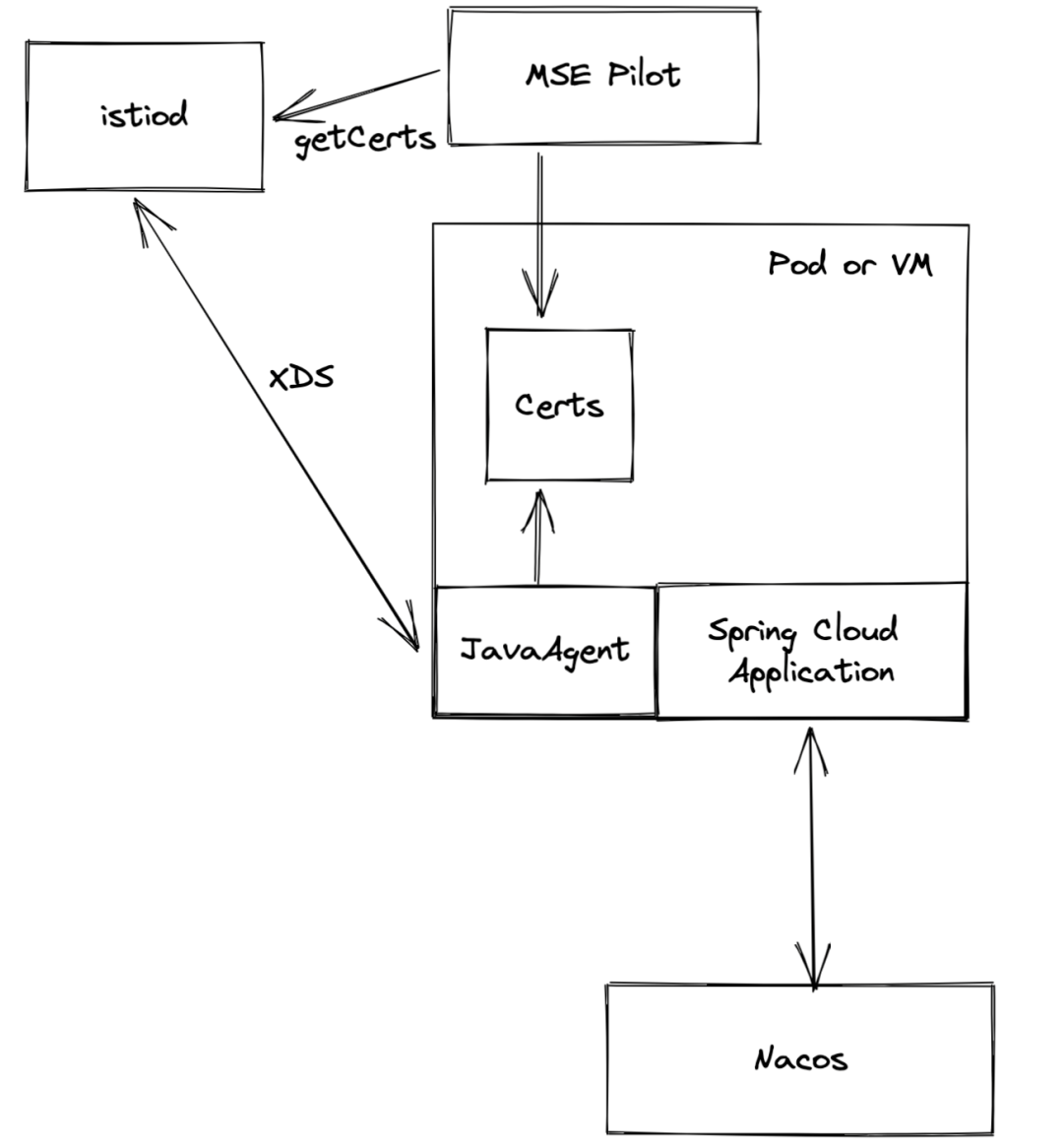
On the other hand, compared with Envoy for Java applications, JavaAgent can provide more governance capabilities (such as service contracts, interface information, database traffic governance, and JVM monitoring and governance).
Let's use a simple practical example to experience how to non-intrusively upgrade Spring Cloud applications to the Proxyless Mesh architecture.
Demo: How can we implement intercommunication between Spring Cloud applications and the multi-language microservices of Service Mesh architecture?
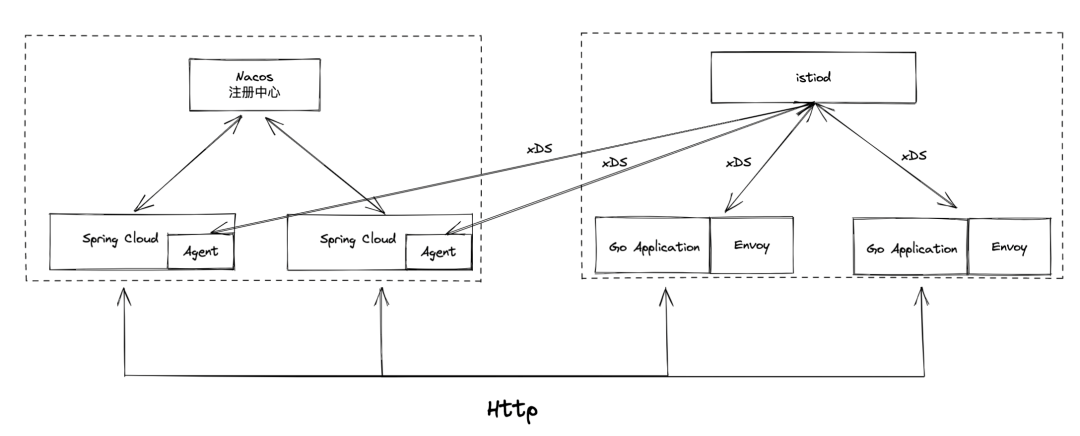
Enable the governance capability of MSE and create an ASM Istio instance for the Kubernetes cluster.
We need to deploy Spring Cloud applications and multi-language Go applications.
Please see the following documentation[3] for an example of the demo application.
Spring Cloud applications call multi-language services the same way other Spring Cloud applications call each other. For example, the A interface that calls the Spring Cloud service (the application name is go-sc-a) using restTemplate is listed below:
restTemplate.getForObject("http://go-sc-a/A", String.class)You can use other methods to call the service. You can directly access the service without using the port number of the service.
We need to add the following environment variables to enable the MSE Agent to support the xDS protocol:
| Type | Variable Name | Variable/Variable Reference | Description |
| Custom | profile.micro.service.envoy.xds.enable | true | Enable MSE service governance to support the xDS protocol |
Spring Cloud services can interoperate with the multi-language service of Service Mesh. The way the Spring Cloud service calls the multi-language services does not require any code changes.
~ curl localhost:20003/go
[Java Spring Cloud ] -> [Service Mesh APP10.191.XX.XX ]~ curl localhost:8085/java
[ Service Mesh APP ] -> [Java Spring Cloud10.191.XX.XX]This article uses a Demo to demonstrate how the SpringCloud application can support Proxyless Mesh without modifying any code when connected to the MSE service governance. Currently, the support for MSE service governance has some limitations, which are being improved. The Proxyless mode of MSE service governance supports basic service discovery and the Subset capability of DestinationRule. You can use MSE traffic governance to implement end-to-end canary release, label-based routing, and other governance capabilities in the Mesh architecture.
It is also worth mentioning that we are working with CloudWeGo, Kratos, Spring Cloud Alibaba, Dubbo, ShardingSphere, Database Mesh, and other communities to build OpenSergo microservice governance standards. We hope to summarize the scenarios and best practices of microservice governance in enterprises and communities into standards and specifications.
We welcome more communities and enterprises to participate in the co-construction of OpenSergo microservice governance standards. The OpenSergo community is now in a high-speed development stage. There is still a lot of evolution work, including defining microservice governance standards, implementing Control Plane, implementing multi-language SDK and governance functions (such as Java, Go, C++, and Rust), and integrating and implementing various microservice ecosystems. You are welcome to participate in the standard improvement and code contribution.
The OpenSergo open-source contribution group is recruiting contributors. If you have time, enthusiasm, and willingness, please contact the community to join the open-source contribution group. Let's work together to improve OpenSergo and Sentinel and lead the evolution of microservice governance technologies and standards.
[1] https://www.envoyproxy.io/docs/envoy/latest/api-docs/xds_protocol
[2] https://istio.io/latest/blog/2021/proxyless-grpc/
[3] https://www.alibabacloud.com/help/en/microservices-engine/latest/best-practices-2
Higress Practice: Use 30 Lines of Code to Write a Wasm Go Plugin

508 posts | 48 followers
FollowAlibaba Cloud Native Community - August 23, 2023
Aliware - August 18, 2021
Alibaba Cloud Native - October 9, 2021
Alibaba Cloud Native Community - November 22, 2023
Alibaba Cloud Native - November 3, 2022
Alibaba Cloud Native Community - July 20, 2021

508 posts | 48 followers
Follow Function Compute
Function Compute
Alibaba Cloud Function Compute is a fully-managed event-driven compute service. It allows you to focus on writing and uploading code without the need to manage infrastructure such as servers.
Learn More Elastic High Performance Computing Solution
Elastic High Performance Computing Solution
High Performance Computing (HPC) and AI technology helps scientific research institutions to perform viral gene sequencing, conduct new drug research and development, and shorten the research and development cycle.
Learn More Quick Starts
Quick Starts
Deploy custom Alibaba Cloud solutions for business-critical scenarios with Quick Start templates.
Learn More ECS(Elastic Compute Service)
ECS(Elastic Compute Service)
Elastic and secure virtual cloud servers to cater all your cloud hosting needs.
Learn MoreMore Posts by Alibaba Cloud Native Community